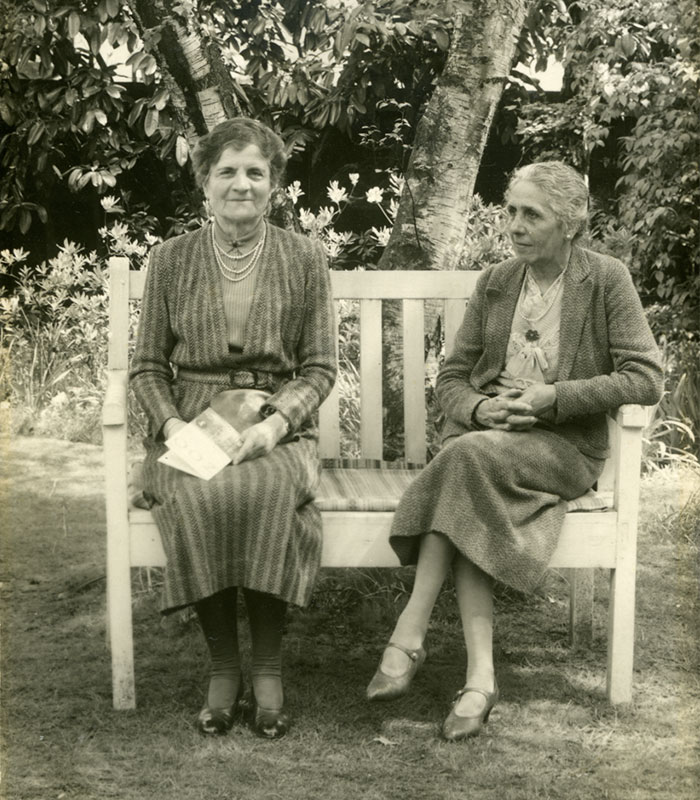

Queer Places:
Bassetts, Southwell Park
Road, Camberley, Surrey
Bible Christian Chapel, 11 Berkeley Vale, Falmouth TR11 3PL, UK
University of Oxford, Oxford, Oxfordshire OX1 3PA
 Ethel Mary Charles (25 March 1871 – April 1962) was the first woman
Architect in 1892. The Charles sisters were the first women to be elected
associate members of the Royal Institute of British Architects (RIBA), in 1900
and 1898 respectively. Forbidden to train at the Architectural Association’s
school because of their gender, they joined a practice in London in 1892 and
learned on the job, working professionally (though sporadically) before the
First World War.
Ethel Mary Charles (25 March 1871 – April 1962) was the first woman
Architect in 1892. The Charles sisters were the first women to be elected
associate members of the Royal Institute of British Architects (RIBA), in 1900
and 1898 respectively. Forbidden to train at the Architectural Association’s
school because of their gender, they joined a practice in London in 1892 and
learned on the job, working professionally (though sporadically) before the
First World War.
She was a British architect, the first woman to be admitted to the Royal Institute of British Architects (RIBA) in 1898.[1]
Ethel Charles and her sister Bessie Ada Charles were born in Calcutta, Bengal India, to Thomas Edmonton Charles (1834–1906), a doctor in private practice, and Ada Henrietta Charles (1848–1931/2).[2] The family left India in 1877, settling at first in Cannes, then for twenty years spent their summers in Switzerland and winters in Rome, and visiting to England annually. Ethel and Bessie Charles were both educated privately and together read modern languages at Somerville College, Oxford for a year in 1891–2. Despite being presented at court, their father encouraged both daughters to explore a profession.
Between 1892–5 Ethel and Bessie were articled to Sir Ernest George and Peto, the architectural practice of Ernest George and Harold Peto. In 1893, they both attempted to continue their training by attending the Architectural Association School of Architecture but were refused entry. Ethel completed part of the course offered by the Bartlett School of Architecture,[3] receiving distinctions. Drawings in the RIBA Collection document her travels through England, France and Italy. After her apprenticeship with Ernest George, she became an assistant to Walter Cave, studying Gothic and domestic architecture. In June 1898, she passed the RIBA examinations for associate membership. RIBA President at the time, Professor George Aitchison, welcomed Ethel and W. Hilton Nash stated "It would be prejudicial to the interests of the Institute to elect a lady member." (p16 W. Hilton Nash)[4]. Nevertheless, her admission was opposed by a minority of members.[5] Despite this initial opposition, she was finally granted membership with 51 voting in favor and 16 against.[6][7] In 1902 she made a representation to the Architectural Association for women to be accepted as practicing architects. However, the Association would not admit any women until 1917. Ethel and Bessie Charles worked and practiced together, building houses on Gyllyngyvase Terrace, Falmouth (1907).[4] Unable to obtain commissions for large-scale projects which continued to be reserved for men, Ethel Charles was forced to concentrate on modest housing projects such as laborers' cottages,[8] often working with her sister, the second woman to become a member of RIBA. Charles stated publicly that the best opportunities for architects were in commercial commissions but the only reference to her work on large-scale designs is an untraced prize-winning church in Germany in 1905. The same year she was awarded the RIBA Silver Medal.[6] Ethel Charles' orthographic projections of laborers' cottages from 1895 are presented by RIBA as an example of how the Old English style began to evolve towards the Arts and Crafts and Garden City movements.[9]
After the First World War, Charles does not appear to have practiced but kept house for a brother, the commandant of the Royal Military Academy. Ethel Charles died on 8 April 1962 in Haverthwaite, Lancashire. She was cremated and her ashes were interred alongside her sister Bessie who had predeceased her in 1932.
Charles left her architectural drawings and sketchbooks to RIBA, which celebrated her as a pioneer woman architect in 2017.[2][10]
My published books: